
Kaboom! is an action video game published in 1981 by Activision for the Atari 2600. The gameplay was based on the Atari arcade video game Avalanche (1978), with the game now involving a Mad Bomber who drops bombs instead of falling rocks. Kaboom! was programmed by Larry Kaplan with David Crane coding the graphics for the buckets and Mad Bomber. It was the last game designed by Kaplan for Activision, who left the company shortly after the release of the game. The game was later ported by Paul Wilson for the Atari 5200 system.

Star Raiders is a space combat simulator video game created by Doug Neubauer and published in 1980 by Atari, Inc. Originally released for the Atari 400/800 computers, Star Raiders was later ported to the Atari 2600, Atari 5200, and Atari ST. The player assumes the role of a starship fighter pilot, who must protect starbases from invading forces called Zylons. Piloting and combat are shown in the 3D cockpit view, while a 2D galactic map shows the state of the Zylon invasion. Neubauer made the game during in his spare time at Atari, inspired by contemporary media such as Battlestar Galactica and Star Wars, as well as the 1971 mainframe game Star Trek.

Solaris is a space combat video game for the Atari 2600 published in 1986 by Atari. The game involves a player seeking out the planet Solaris via their starship. To accomplish this, the player must navigate the galactic scanner to explore quadrants of a map. Doing so allows them to explore Federation planets to refuel their ship, and engage in combat with hostile aliens known as the Zylons.

Pitfall! is a video game developed by David Crane for the Atari 2600 and released in 1982 by Activision. The player controls Pitfall Harry, who has a time limit of 20 minutes to seek treasure in a jungle. The game world is populated by enemies and hazards that variously cause the player to lose lives or points.

Tennis is a sports video game for the Atari VCS which was written by Activision co-founder Alan Miller and published by Activision in 1981.
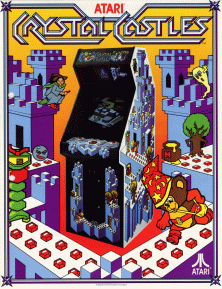
Crystal Castles is an arcade video game released by Atari, Inc. in 1983. The player controls Bentley Bear who has to collect gems located throughout trimetric-projected rendered castles while avoiding enemies, some of whom are after the gems as well.

Phoenix is a fixed shooter video game developed for arcades in Japan and released in 1980 by Taito. The player controls a space ship shooting at incoming enemies that fly from the top of the screen down towards the player's ship. There are five stages which repeat endlessly. The fifth is a fight against a large enemy spaceship, making Phoenix one of the first shooters with a boss battle, an element that would become common for the genre.
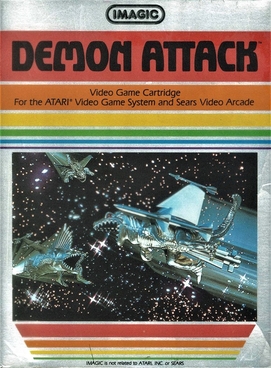
Demon Attack is a fixed shooter video game created by Rob Fulop for the Atari 2600 and published by Imagic in 1982. The game involves the player controlling a laser cannon from the surface of a planet, shooting winged demons that fly down and attack the player in different sets of patterns.
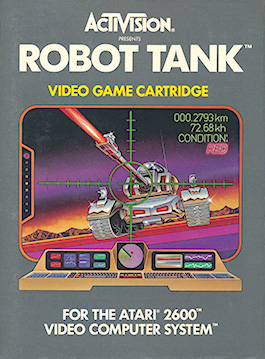
Robot Tank is a first-person shoot 'em up written by Alan Miller for the Atari 2600 and published by Activision in 1983. It is similar in design to Atari, Inc.'s Battlezone tank combat arcade video game and more so to its 2600 port. Robot Tank adds different systems which can individually be damaged—instead of the vehicle always exploding upon being shot—and weather effects.

Keystone Kapers is a platform game developed by Garry Kitchen for the Atari 2600 and published by Activision in 1983. The game involves a Keystone Cops-theme, with the player controlling police officer Kelly, who traverses the many levels of a department store, dodging objects to catch the escaped thief Harry Hooligan.

Chopper Command is a horizontally scrolling shooter released by Activision for the Atari 2600 in June 1982. It was written by Bob Whitehead. The player flies a helicopter left and right over a scrolling, wraparound landscape, shooting down enemy airplanes to protect a convoy of trucks below.
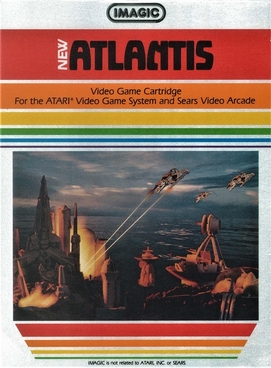
Atlantis is a fixed shooter video game released by Imagic in July 1982 for the Atari 2600. It was written by Dennis Koble who also wrote Trick Shot for Imagic. Atlantis was ported to the Atari 8-bit computers, VIC-20, Intellivision, and Magnavox Odyssey 2.
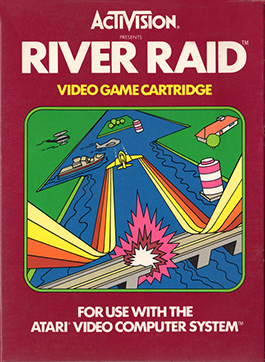
River Raid is a video game developed by Carol Shaw for the Atari Video Computer System and released in 1982 by Activision. The player controls a fighter jet over the River of No Return in a raid behind enemy lines. The goal is to navigate the flight by destroying enemy tankers, helicopters, fuel depots and bridges without running out of fuel or crashing.

Pitfall II: Lost Caverns is a video game developed by David Crane for the Atari 2600. It was released in 1984 by Activision. The player controls Pitfall Harry, who must explore in wilds of Peru to find the Raj Diamond, and rescue his niece Rhonda and their animal friend Quickclaw. The game world is populated by enemies and hazards that variously cause the player to lose points and return to a checkpoint.

Ice Hockey is an ice hockey video game designed by Alan Miller for the Atari VCS, and published by Activision in 1981. Actor and comedian Phil Hartman starred in the commercial for the game.

Megamania is a fixed shooter video game developed by Steve Cartwright for the Atari 2600. It was published by Activision in 1982. A pilot of an intergalactic space cruiser has a nightmare where his ship is being attacked by food and household objects. Using the missile launcher from their space cruiser, the pilot fends of the attackers. The game was later released for the Atari 5200 and Atari 8-bit computers.

Enduro is a racing video game designed by Larry Miller for the Atari 2600 and published by Activision in 1983. The object of the game is to complete an endurance race, passing a certain number of cars each day to continue the next day. The visuals change from day to night, and there is occasional inclement weather.
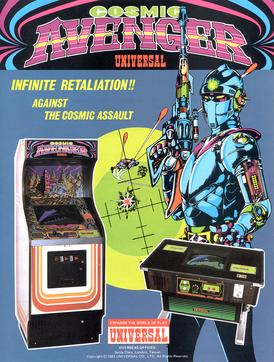
Cosmic Avenger is a scrolling shooter developed by Universal and released as an arcade video game in July 1981. It is part of the first wave shooters with forced horizontal scrolling which followed Konami's Scramble and Super Cobra from earlier in the year. It was released the same month as Vanguard. The final installment in Universal's Cosmic series, players take control of the Avenger space fighter and, as in Scramble, use bullets and bombs against enemy air and ground forces. The world is one continuous level made up of different areas.

Space Cavern is a 1982 fixed shooter video game for the Atari 2600 developed and released by Games by Apollo. Players control a spaceship commander who has landed on a planet and must defend the ship against its hostile creatures. Games by Apollo founder Pat Roper was impressed by the game Demon Attack and tasked Apollo member Dan Oliver with making a game very similar to it.

Demons to Diamonds is a fixed shooter for the Atari 2600 produced by Atari, Inc. and released in 1982. It was programmed by Nick Turner with graphics designed by Alan Murphy. Nick Turner previously ported Super Breakout to the 2600. The manual states that the game was primarily designed for children in the 6 to 12 age range.






















